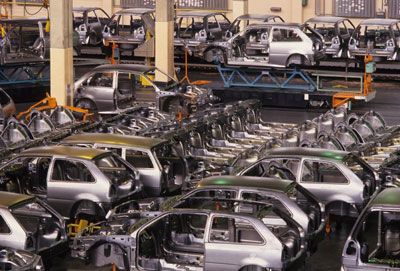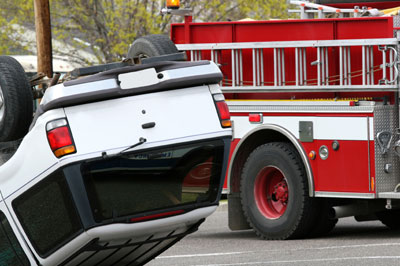Florida SUV Rollover Accident Lawyers
THE BIGGEST CULPRIT IN SUV ROLLOVERS IS DEFECTIVE DESIGN

A primary cause of SUV rollovers is defective design, whether in the tires – which support the SUVs center of gravity – or other vehicle parts. Defective tires can be especially lethal: When the tread separates while a SUV is going at high speed, the driver can no longer control the vehicle.
Rollovers would not be deadly if SUVs were designed differently. There’s not much debate among safety experts: Roof crush is the most lethal defect in SUV rollover accident. Roofs crush drivers and passengers, and the collapse of roof supports can eject occupants and expose them to even greater injury. In a 2008 study conducted by the Insurance Institute for Highway Safety on eleven mid-sized SUVs, the vehicles with the strongest roofs demonstrated nearly half the injury risks of those with the weakest roofs.
Further research by the NHTSA confirmed that, in actual rollovers, injury risk decreases as measurable roof strength increases. Fortunately, lawmakers listened and stringent roof crush standards were implemented in 2009. A new rule requires that a roof withstand an applied force equal to three times the vehicle’s weight while maintaining sufficient headroom for an average size adult man.
OUR PRODUCT LIABILITY ATTORNEYS HELOP SUV ROLLOVER VICTIMS
Here is just one of the tragic SUV rollover cases our Florida auto accident lawyers have handled:
The auto accident lawyers at Searcy Denney represented a Florida family whose Ford Bronco II went into a spin when a tire blew, rolling over onto the passenger side roof edge. The passenger in the front seat sustained severe injuries to her skull and forehead. As the Bronco continued to roll over, window glass shattered and two back seat passengers were ejected and killed.
The Searcy Denney team’s meticulous investigation linked the two deaths, and the front-seat passenger’s injuries, to the Bronco’s rollover and crushed roof. It became clear that Ford Motor Company had known since the 1980s that the Bronco II could roll over, even in ordinary use. But the company failed to design a roll cage or other protective device that would protect occupants. In addition, Ford failed to provide window glass that would not shatter and allow passengers to be ejected.
Ford Motor Company hired high-powered defense attorneys from Florida and Colorado, but after extensive mediation and negotiation, Searcy Denney was able to negotiate a seven-figure confidential settlement.
ROLLOVERS OCCUR WHEN AUTOMAKERS IGNORE SAFETY LAWS
The history of federal regulation and safety standards for the automobile industry is lengthy but, some would say, has had only limited impact in protecting the lives of drivers and passengers. Automobile design legislation was first passed by Congress in 1940, but there was little focus on vehicle safety until the mid-1960s, when consumer advocate Ralph Nader published a damning indictment of the auto industry in his book, Unsafe at Any Speed. Pressured by sudden public attention to safety, in 1966 Congress made installation of seat belts mandatory and established the beginnings of what in 1970 became the National Highway Traffic Safety Administration, which is part of the Department of Transportation.
Over the years, NHTSA has promulgated a number of important safety regulations, which are enforced primarily through its authority to require automakers to recall vehicles that NHTSA finds do not meet established safety standards. The agency provides on-line access to databases that list the results of testing of vehicles’ compliance with Federal Motor Vehicle Safety Standards, NHTSA vehicle defect investigations, consumer complaints, and recalls – which have totaled more than half a billion since NHTSA’s inception.
One of the most controversial regulatory dilemmas the NHTSA has faced is the question of roof strength standards. It is NHTSA’s responsibility to make sure that automobile manufacturers comply with federal law in notifying the agency within five days of identifying a safety problem, and promptly conducting a recall. It has been credibly established that the weak and flimsy roofs in SUVs currently made and sold are major culprits in SUV rollover deaths, brain injuries, and paralysis.
HOW ROOF CRUSH STANDARDS HAVE IMPROVED SUV SAFETY
The early roof crush standards developed in the 1970s proved ineffective as SUVs became more popular, so in 2009 the NHTSA mandated stricter standards (Federal Motor Vehicle Standard 216). The 2009 FMVSS for roof crush resistance covers SUVs and pickup trucks weighing up to 10,000 pounds, and requires that roofs must be able to withstand a force equal to three times their weight without collapsing.
To test compliance with roof crush standards, a rigid plate is pushed into one side of the roof at a constant speed, and the roof must be strong enough to keep the plate from moving more than five inches when subject to a force equal to three times the weight of the vehicle, while maintaining sufficient headroom for an average-sized adult male. Under earlier rules, both sides were required to meet the standard, but only one side was subjected to a test. Now, the updated FMVSS 216 standard calls for two tests, one on each side of the vehicle.
Updated roof crush standards have been phased in, beginning with 2013 models; by the model year 2017, all automakers were required to be in compliance with all of their products. But if history is any indication, SUV drivers and their passengers may still be at risk from roof crush crashes. Manufacturers of these “big beast” vehicles argue that putting more steel in roofs adds weight and cost – not only to the price of buying a car, but to fuel economy at a time when gas prices have skyrocketed.
Recent evidence has surfaced that at least one major carmaker has been fudging its test numbers for years. Recently-released documents published on consumer group Public Citizen’s website indicate that, beginning 45 years ago, when the federal government first was attempting to establish roof strength standards, General Motors concealed internal test results that might have supported tougher requirements. This enabled GM and some of its counterparts to continue to make vehicles that put drivers and passengers at risk of serious injury.
ESC: ANOTHER ADVANCE IN SUV ROLLOVER PREVENTION
When installed in a SUV, an Electronic Stability Control (ESC) system can sense warning signs of a rollover and quickly adjust brakes or engine speed, allowing the driver to maintain – or regain – control. Under federal law, ESC systems were adopted universally in all model 2013 vehicles.
The NHTSA estimates that ESC could reduce SUV single-vehicle crashes by 59%, and, once all light vehicles are equipped with ESC, up to 9,600 deaths and as many as 238,000 vehicle accident injuries could be prevented each year. But the Insurance Institute for Highway Safety cautions that from 5,000 to 6,000 SUV rollover fatalities are still likely to occur each year. ESC cannot maintain control in all situations, such as an accident where the impact of another vehicle or a roadside obstacle has initiated the rollover, or in the case of a tire blowout or loss of traction on a wet road.
WHAT’S NEXT? MORE PROPOSALS TO MAKE SUVS SAFER
While some progress has been made in setting safety standards for SUVs, many consumer organizations argue that they have not gone far enough. Rollovers and roof crush are not the only challenges to SUV safety, says the Insurance Institute for Highway Safety. IIHS is pushing for SUVs to be subject to regulations requiring car bumpers to be a standard 16 to 20 inches off the ground. Right now, SUV bumpers are several inches higher, resulting in crashes, injuries and damage that IIHS claims could easily be prevented.
Since 2012, the Insurance Institute for Highway Safety has been conducting “small overlap” testing in SUVs in order to recommend design changes that will improve safety. The small overlap frontal crash test replicates what happens when the front corner of an SUV collides with another vehicle or a hard surface such as a pole or wall at 40 miles an hour. Frontal crashes of this kind are one of the major causes of death or serious injury to drivers, and some automakers are taking into consideration results of these tests by strengthening their SUV bumpers and frames and installing more effective airbags.
Other recommendations for safer SUVs include reinforcing windshields, windows and doors, and improving restraint systems. In February 2013, Consumer Reports called for more research into the risks of third row seats. Because they are so close to the rear, third-row seats leave passengers – which are usually children – more vulnerable if a rear-end crash should occur. What’s more, the minimal headroom above third-row seats leaves little roof crush space, increasing passengers’ risk of severe or fatal head injuries.
EXPERIENCED PRODUCT LIABILITY LAWYERS FIGHT FOR JUSTICE FOR YOU
If a loved one has been killed or you or a family member has been injured in an accident caused by a defective vehicle, the trial lawyers at Searcy Denney can bring their experience, resources, and professional team to your pursuit of justice. Fill out our Contact Form or call us at 1-855-685-1843 to learn more and arrange for a confidential free consultation with our West Palm Beach, Tallahassee or Tampa product liability lawyers.




